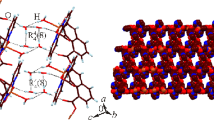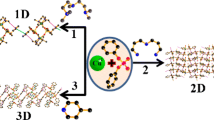Abstract
A new example of phosphonium cation, [P(NH3Py)4]+, (2) featuring 3-pyridyl substituents has been reported. Reactivity of 2 with KOH in methanol have resulted in the formation of a neutral phosphine imine [P(N3Py)(NH3Py)3], 2-H. Treatment of 2 with various metal salts of copper have resulted in a P–N bond cleavage in which the in situ generated phosphoramide ligand [PO(NH3Py)3], 1, has shown to yield interesting kinds of self-assembled structures in macrocyclic, cage and 2D-coordination polymers. Thus, the reaction of 2 with Cu(NO3)2 in methanol gave the supramolecular [M6L8]12+ type cage reported earlier with the phosphoramide 1. Treatment of 2 with a Cu(I) salt in CHCl3 under ambient conditions have lead to the formation of a 20-membered macrocyclic Cu(II) compound [(PO(NH3Py)3)CuCl2]2, 3, via the in situ oxidation of Cu(I). In another reaction, treatment of 1 or 2 with Cu(NO3)2 in a reducing solvent such as dimethylformamide (DMF) under hydrothermal conditions gave a Cu(I) coordination polymer {[Cu2(PO(NH3Py)3)3](NO3)2}n, 4. Crystallographic studies on all these newly synthesized compounds have shown interesting kinds of supramolecular organization for these molecules.
Graphical Abstract
New examples of a phosphonium cation, [P(NH3Py)4]+, and a phosphine imine, [P(N3Py)(NH3Py)3] featuring 3-pyridyl substituents have been reported. Treatment of the phosphonium cation with various metal salts of copper have resulted in a P–N bond cleavage in which the in situ generated phosphoramide ligand [PO(NH3Py)3], has shown to yield interesting kinds of self-assembled structures in macrocyclic, cage and 2D-coordination polymers.






Similar content being viewed by others
References
Cram DJ (1992) Molecular container compounds. Nature 356:29–36
Ajami D, Rebek J Jr (2008) Gas behavior in self-assembled capsules. Angew Chem Int Ed 47:6059–6061
Pan D, Turner JL, Wooley KL (2003) Folic acid-conjugated nanostructured materials designed for cancer cell targeting. Chem Commun 19:2400–2401
Ma Y, Li H, Peng S, Wang L (2012) Highly selective and sensitive fluorescent paper sensor for nitroaromatic explosive detection. Anal Chem 84:8415–8842
Leung DH, Bergman RG, Raymond KN (2006) Scope and mechanism of the C–H bond activation reactivity within a supramolecular host by an iridium guest: a stepwise ion pair guest dissociation mechanism. J Am Chem Soc 128:9781–9797
Fujita M, Tominaga M, Hori A, Therrien B (2005) Coordination assemblies from a Pd(II)-cornered square complex. Acc Chem Res 38:369–378
Romanescu C, Galeev TR, Li W-L, Boldyrev AI, Wang L-S (2013) Transition-metal-centered monocyclic boron wheel clusters (M©Bn): a new class of aromatic borometallic compounds. Acc Chem Res 46:350–358
Hailian Li, Mohamed E, O'Keeffe M, Yaghi OM (1999) Design and synthesis of an exceptionally stable and highly porous metal-organic framework. Nature 402:276–279
Li J-R, Zhou H-C (2010) Bridging-ligand-substitution strategy for the preparation of metal-organic polyhedra. Nat Chem 2:893–898
Tanase T, Hatada S, Mochizuki A, Nakamae K, Kure B, Nakajima T (2013) Flexible, linear, tetranuclear palladium complexes supported by tetraphosphine ligands with electron-withdrawing groups. Dalton Trans 42:15941–15952
Chand DK, Biradha K, Fujita M, Sakamoto S, Yamaguchi K (2002) A molecular sphere of octahedral symmetry. Chem Commun 2486–2487
Chivers T, Krahn M, Schatte G, Parvez M (2003) Lithiation of tris(alkyl- and arylamido)orthophosphates EP[N(H)R]3 (E = O, S, Se): imido substituent effects and P = E bond cleavage. Inorg Chem 42:3994–4005
Gupta AK, Chipem FAS, Boomishankar R (2012) A 2-pyridyl (py) attached phosphine imine [P(Npy)(NHpy)3] and an imido phosphinate ion [P(Npy)2(NHpy)2]− in its Ag(I) complex. Dalton Trans 41:1848–1853
Gupta AK, Steiner A, Boomishankar R (2012) Tri-, hepta- and octa-nuclear Ag(I) complexes derived from 2-pyridyl-functionalized tris(amido)phosphate ligand. Dalton Trans 41:9753–9759
Gupta AK, Nagarkar SS, Boomishankar R (2013) Zn(II) coordination polymer of an in situ generated 4-pyridyl (4Py) attached bis(amido)phosphate ligand, [PO2(NH4Py)2]− showing preferential water uptake over aliphatic alcohols. Dalton Trans 42:10964–10970
Li X-J, Jiang F-L, Wu M-Y, Zhang S-Q, Zhou Y-F, Hong M-C (2012) Self-assembly of discrete M6L8 coordination cages based on a conformationally flexible tripodal phosphoric triamide ligand. Inorg Chem 51:4116–4122
Tsuji J, Kezuka H, Takayanagi H, Yamamoto K (1981) Oxidative cleavage reaction of 3-substituted indoles catalyzed by CuCl-pyridine complex under oxygen. Bull Chem Soc Jpn 54:2369–2373
Pastoriza-Santos I, Liz-Marzán LM (1999) Formation and stabilization of silver nanoparticles through reduction by N,N-dimethylformamide. Langmuir 15:948–951
Mukherjee A, Chakrabarty R, Patra GK (2009) Novel 3-dimensional sixfold interpenetrating diamond networks of copper(I) coordination polymers of polypyridyl-synthesis, characterization and crystal structures. Inorg Chem Commun 12:1227–1230
Etter MC (1990) Encoding and decoding hydrogen-bond patterns of organic compounds. Acc Chem Res 23:120–126
O'Keeffe M, Yaghi O M (2012) Deconstructing the crystal structures of metal–organic frameworks and related materials into their underlying nets. Chem Rev 112:675–702
Monzyk B, Crumbliss AL, Kubas GJ (1990) Tetrakis(acetonitrile) copper (1+) hexafluorophosphate (1−). Inorg Synth 28:68–69
Sheldrick GM (1998) A short history of SHELX. Acta Crystallorgr A64:112–122
Acknowledgments
The authors thank DST, India and IISER, Pune for financial support. AY thanks CSIR, India for a fellowship.
Author information
Authors and Affiliations
Corresponding author
Electronic supplementary material
Below is the link to the electronic supplementary material.
Rights and permissions
About this article
Cite this article
Gupta, A.K., Yadav, A. & Boomishankar, R. Discrete and Polymeric Coordination Assemblies Derived from 3-Pyridyl Attached Flexible Phosphoric Triamide Ligand and Copper Salts. Proc. Natl. Acad. Sci., India, Sect. A Phys. Sci. 84, 205–212 (2014). https://doi.org/10.1007/s40010-014-0135-7
Received:
Accepted:
Published:
Issue Date:
DOI: https://doi.org/10.1007/s40010-014-0135-7




